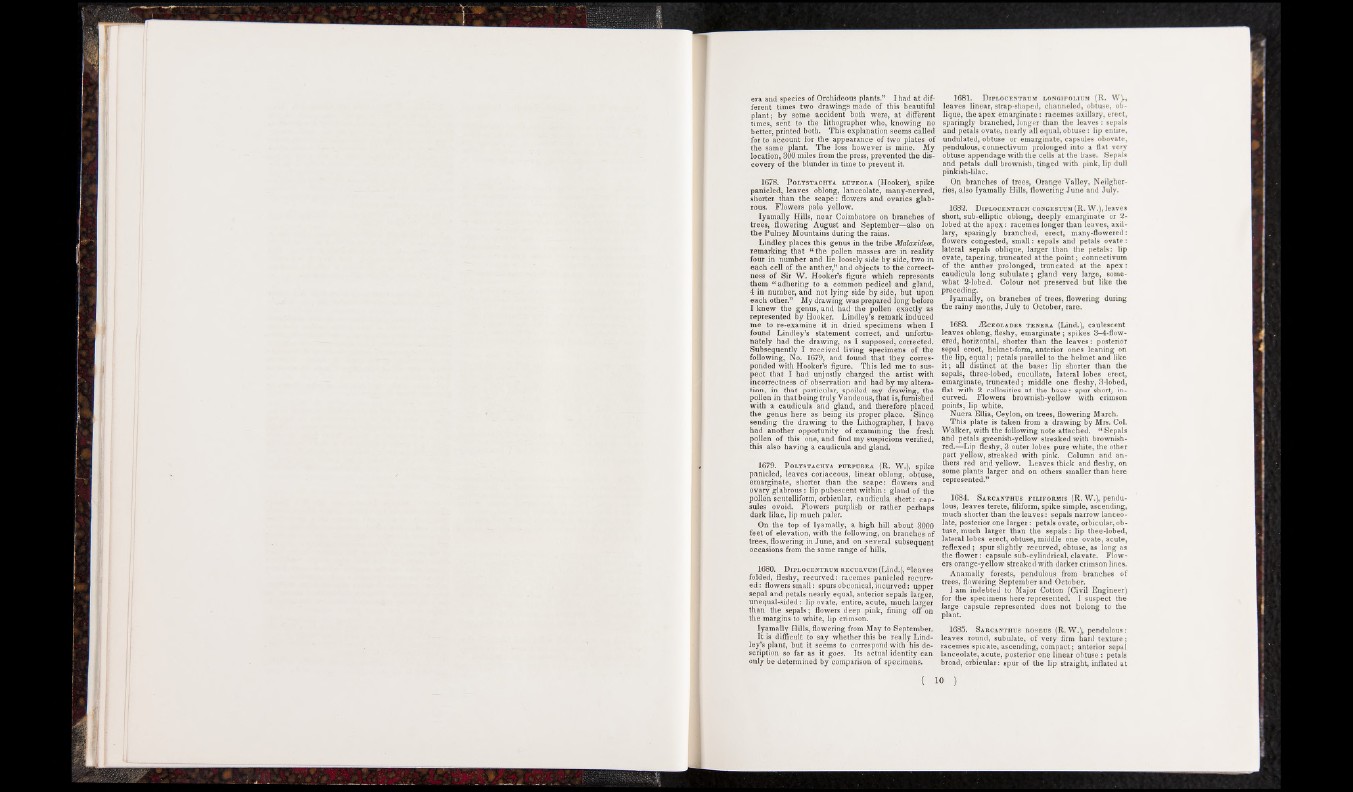
era and species of Orchideous plants.” I had at different
times two drawings made of this beautiful
plant; by some accident both were, at different
times, sent to the lithographer who, knowing no
better, printed both. This explanation seems called
for to account for the appearance of two plates of
the same plant. The loss however is mine. My
location, 300 miles from the press, prevented the discovery
of the blunder in time to prevent it.
1678. Polystachya luteola (Hooker), spike
panicled, leaves oblong, lanceolate, many-nerved,
shorter than the scape: flowers and ovaries glabrous.
Flowers pale yellow.
Iyamally Hills, near Coimbatore on branches of
trees, flowering August and September—also on
the Pulney Mountains during the rains.
Lindley places this genus in the tribe Malaxideoe,
remarking that “ the pollen masses are in reality
four in number and lie loosely side by side, two in
each cell of the anther,” and objects to the correctness
of Sir W. Hooker’s figure which represents
them “ adhering to a common pedicel and gland,
4 in number, and not lying side by side, but upon
each other.” My drawing was prepared long before
I knew the genus, and had the pollen exactly as
represented by Hooker. Lindley’s remark induced
me to re-examine it in dried specimens when I
found Lindley’s statement correct, and unfortunately
had the drawing, as I supposed, corrected.
Subsequently I received living specimens of the
following, No. 1679, and found that they corresponded
with Hooker’s figure. This led me to suspect
that I had unjustly charged the artist with
incorrectness of observation and had by my alteration,
in that particular, spoiled my drawing, the
pollen in that being truly Vandeous, that is, furnished
with a caudicula and gland, and therefore placed
the genus here as being its proper place. Since
sending the drawing to the Lithographer, I have
had another opportunity of examining the fresh
pollen of this one, and find my suspicions verified,
this also having a caudicula and gland.
1679. Polystachya purpurea (R. W.), spike
panicled, leaves coriaceous, linear oblong, obtuse,
emarginate, shorter than the scape: flowers and
ovary glabrous : lip pubescent within : gland of the
pollen scutelliform, orbicular, caudicula short : capsules
ovoid. Flowers purplish or rather perhaps
dark lilac, lip much paler.
On the top of Iyamally, a high hill about 3000
feet of elevation, with the following, on branches of
trees, flowering in June, and on several subsequent
occasions from the same range of hills.
1680. Diplocentrum RECURvuM(Lind.), “leaves
folded, fleshy, recurved: racemes panicled recurved
: flowers small : spurs obconical, incurved : upper
sepal and petals nearly equal, anterior sepals larger,
unequal-sided : lip ovate, entire, acute, much larger
than the sepals ; flowers deep pink, fining off on
the margins to white, lip crimson.
Iyamally Hills, flowering from May to September.
It is difficult to say whether this be really Lindley’s
plant, but it seems to correspond with his description
so far as it goes. Its actual identity can
only be determined by comparison of specimens.
1681. Diplocentrum longifolium (R. W).,
leaves linear, strap-shaped, channeled, obtuse, oblique,
the apex emarginate: racemes axillary, erect,
sparingly branched, longer than the leaves: sepals
and petals ovate, nearly all equal, obtuse: lip entire,
undulated, obtuse or emarginate, capsules obovate,
pendulous, connectivum prolonged into a flat very
obtuse appendage with the cells at the base. Sepals
and petals dull brownish, tinged with pink, lip dull
pinkish-lilac.
On branches of trees, Orange Valley, Neilgher-
ries, also Iyamally Hills, flowering June and July.
1682. Diplocentrum congestum (R. W.), leaves
short, sub-elliptic oblong, deeply emarginate or 2-
lobed at the apex: racemes longer than leaves, axillary,
sparingly branched, erect, many-flowered:
flowers congested, small: sepals and petals ovate:
lateral sepals oblique, larger than the petals: lip
ovate, tapering, truncated at the point; connectivum
of the anther prolonged, truncated at the apex:
caudicula long subulate; gland very large, somewhat
2-lobed. Colour not preserved but like the
preceding.
Iyamally, on branches of trees, flowering during
the rainy months, July to October, rare.
1683. jE ceolades tenera (Lind.), caulescent
leaves oblong, fleshy, emarginate ; spikes 3-4-flow-
ered, horizontal, shorter than the leaves: posterior
sepal erect, helmet-form, anterior ones leaning on
the lip, equal; petals parallel to the helmet and like
it; all distinct at the base: lip shorter than the
sepals, three-lobed, cucullate, lateral lobes erect,
emarginate, truncated; middle one fleshy, 3-lobed,
flat with 2 callosities at the base: spur short, incurved.
Flowers brownish-yellow with crimson
points, lip white.
Nuera Ellia, Ceylon, on trees, flowering March.
This plate is taken from a drawing by Mrs. Col.
Walker, with the following note attached. “ Sepals
and petals greenish-yellow streaked with brownish-
red.—Lip fleshy, 3 outer lobes pure white, the other
part yellow, streaked with pink. Column and anthers
red and yellow. Leaves thick and fleshy, on
some plants larger and on others smaller than here
represented.”
1684. Sarcanthus filiformis (R. W.), pendulous,
leaves terete, filiform, spike simple, ascending,
much shorter than the leaves: sepals narrow lanceolate,
posterior one larger: petals ovate, orbicular, obtuse,
much larger than the sepals: lip thee-lobed,
lateral lobes erect, obtuse, middle one ovate, acute,
reflexed ; spur slightly recurved, obtuse, as long as
the flower: capsule sub-cylindrical, clavate. Flowers
orange-yellow streaked with darker crimson lines.
Anamally forests, pendulous from branches of
trees, flowering September and October.
I am indebted to Major Cotton (Civil Engineer)
for the specimens here represented. I suspect the
large capsule represented does not belong to the
plant.
1685. Sarcanthus roseus (R. W.), pendulous:
leaves round, subulate, of very firm hard texture;
racemes spicate, ascending, compact; anterior sepal
lanceolate, acute, posterior one linear obtuse: petals
broad, orbicular: spur of the lip straight, inflated at